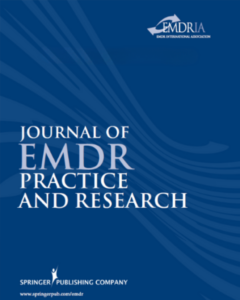The role of alternating bilateral stimulation in establishing positive cognition in EMDR therapy: A multi-channel near-infrared spectroscopy study (PLOS One)
This article looks at the effects of bilateral stimulation in EMDR therapy’s resource development and installation (RDI) by way of multi-channel near-infrared spectroscopy imaging.
Read MoreCohérence électroencéphalographique, vivacité des souvenirs et effets de valence émotionnelle des mouvements oculaires bilatéraux pendant le rappel de souvenirs désagréables et l’association libre subséquente : implications pour l’EMDR (Journal of EMDR Practice and Research)
Cette étude a examiné les effets de la stimulation bilatérale pendant le rappel de souvenirs désagréables suivi d’association libre, de…
Read MoreLes effets des mouvements oculaires bilatéraux sur la cohérence EEG lors du rappel d’un souvenir plaisant (Journal of EMDR Practice and Research)
Dans une enquête sur le modèle de cohérence interhémisphérique (CIh) dans la désensibilisation et le retraitement par les mouvements…
Read MoreFifteen to Twenty Seconds of Eye Movements Have No Effect on Believability of Positive Personal Verbal Statements: Results From a Working Memory Study (Journal of EMDR Practice and Research)
Undergraduates performed eye movements while focusing on positive verbal statements of a relevant personality trait (e.g., “I’m persistent”).
Read MoreAn Integrative Model for the Neural Mechanism of Eye Movement Desensitization and Reprocessing (EMDR) (Frontiers in Behavioral Neuroscience)
Coubard’s TIMER-RIDER model explores bilateral stimulation, physiological mechanisms, and neural mechanisms of EMDR.
Read MoreThe Role of Eye Movements in EMDR: Conducting Eye Movements While Concentrating on Negative Autobiographical Memories Results in Fewer Intrusions (Journal of EMDR Practice and Research)
The aim of this research was to evaluate the effect of eye movements on vividness, emotionality, and suppression of memories.
Read MoreBilateral drawing: Self-regulation for trauma reparation (Psychology Today)
Bilateral drawing reflects Shapiro’s model of EMDR treatment that involves dual-attention stimulation to help an individual with trauma.
Read MoreIntegration of Religion and Spirituality Into Trauma Psychotherapy: An Example in Suism? (Journal of EMDR Practice and Research)
Summary of cultural applicability of EMDR and research on value of incorporating religion/spirituality, particularly Islamic Sufism.
Read MoreElectroencephalography Coherence, Memory Vividness, and Emotional Valence Effects of Bilateral Eye Movements During Unpleasant Memory Recall and Subsequent Free Association: Implications for Eye Movement Desensitization and Reprocessing (Journal of EMDR Practice and Research)
The effects of bilateral stimulation during unpleasant memory recall followed by free association, similar to Phase 4 of EMDR therapy.
Read MoreEMDR therapy for trauma-related disorders (Springer, 2015)
Shapiro & Laliotis explain how EMDR therapy can be used for trauma-related disorders, guided by the Adaptive Information Processing model.
Read MoreEMDR y el Modelo del Procesamiento Adaptativo de la Información Mecanismos potenciales del cambio (Journal of EMDR Practice and Research)
La desensibilización y el reprocesamiento a través de movimientos oculares (EMDR) es un enfoque terapéutico guiado por el modelo del procesamiento adaptativo…
Read MoreThe Effects of Bilateral Eye Movements on EEG Coherence When Recalling a Pleasant Memory (Journal of EMDR Practice and Research)
Participants were exposed to bilateral eye movements during the contemplation of a positive memory and measured with electroencephalographies.
Read More



